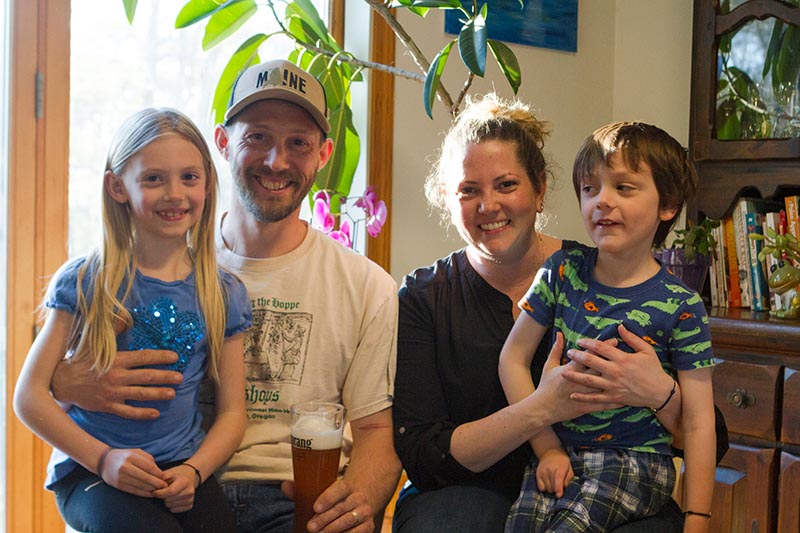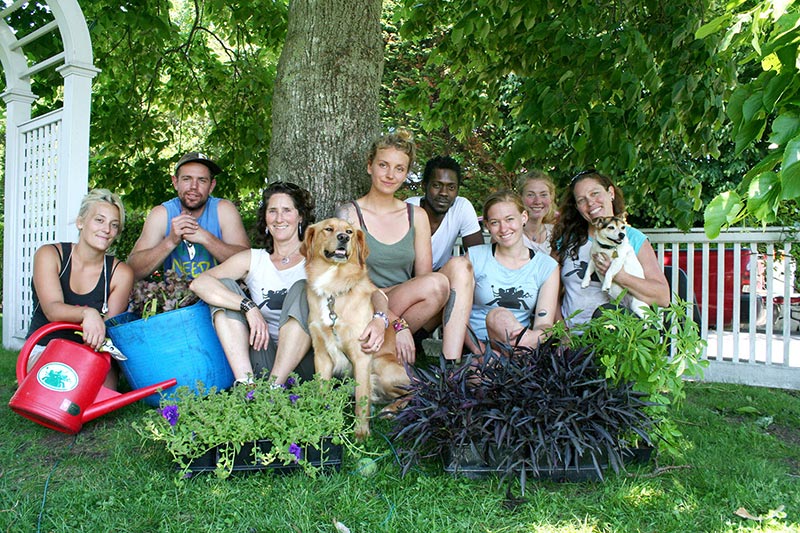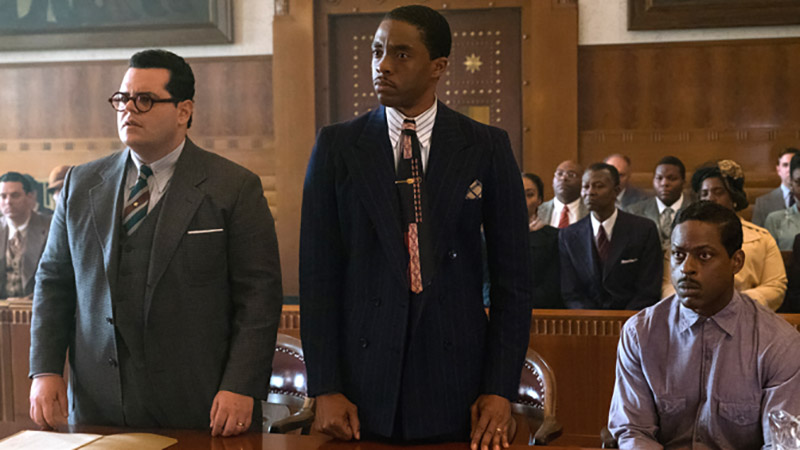The second annual Martha’s Vineyard Mini Maker Faire happened last week. The Faire showcases Island “makers” — beekeepers, sword makers, robot designers, artists, musicians — anyone who has come up with a clever solution or a new idea.
We talked with one of the participants, Obie York, at his house in Vineyard Haven, where he homebrews beer. Being National Homebrew Day, Obie had a Session IPA in the works as he was being interviewed.
So can you just tell me the basics of beer brewing?
Commercial brewers always start with mashing. In this container, there’s all this grain — you’ve got barley malt mainly, but there can be other kinds of grains. It smells kind of like hot breakfast cereal now, because it basically is.
The first step is mashing, and that basically converts the grains into sugar. Through mashing, water and temperature cause the breakdown of starches into sugars, and the sugars are what you ferment into alcohol and the other byproducts that give beer its flavor — but mainly you’re making sugar.

The boil process is basically just a sanitizing thing. For thousands of years people drank beer instead of water because water made you sick. The alcohol preserves [the beer], but ultimately it’s because you boiled it. That’s also when hops go in, because it adds flavor components, but also originally it was a preservative. So they go into boil, and there’s a chemical process that happens there as well. It converts acids in the hops.
After [the boil], it gets cooled down to a specific temperature, and that’s when you put the yeast in, and the yeast ferments the beer, and there’s various pieces of equipment that you use to monitor it, and that’s how you know it’s done.
Big commercial breweries have labs, little craft breweries basically are doing a scaled-up version of my system with better controls. I’m breaking all kinds of rules that commercial brewers would have fits over if they saw me doing it. But that doesn’t matter because I’m not trying to make the same exact thing twice.
So can you explain what you’re doing now?
Sure. I’ve done my mash and I’ve converted all of my grains into sugars, and now I’m going to drain that off into the kettle to boil. That mash was converting for an hour at 151°. The temperature ranges, and depending on what type of beer and what consistency you’re looking for, you can alter those ranges.
And so what effect does the temperature have on the finished beer?
It’s the balance of sugars that you get out of it. There’s two enzymes at work — they’re both amylase enzymes which occur in nature — that function at different temperature ranges. They function in different ways. So you have this big long chain of carbohydrates, and one of the types of amylase cuts that chain in half, and then those chains are cut in half, and on and on. The other one nibbles at the ends and goes cell by cell. So that’s a lot slower process, but it ends up making more simple sugars. That’s at the lower end of the temperature range, and at the higher temperature range you get more complex sugars.
Yeast breaks down simple sugars easier than complex sugars, and anything more than three molecules or so — anything that qualifies as sugar and not a starch — bare yeast won’t break that down. Basically, the cooler you are, the dryer the beer you’re going to get; the hotter you are, the sweeter the beer you’re going to get. So you can balance that temperature range so you can hit a balance between sweet and dry, and that can lend itself to a thinner or fuller beer, depending.
Is it difficult, then, to brew at certain times of the year if you have to be so conscious about temperature?
I have a temperature-controlled chamber that’s built out of a freezer. That’s important too, because the yeast activity will create heat and cause the temperature of the fermenting beer to rise. Commercial brewers try to control that, but homebrewers often don’t because it’s extra equipment.
With the craft beer revolution now, there’s so much experimentation, even in the
commercial breweries. There are certain styles of beer where they let the fermentation run wild, and others where the temperature control is super-important. All the rules are being broken and rewritten all the time in commercial craft beer.
It’s not cheap; Sam Adams used to run this ad campaign where they said that they were putting a pound of hops into their beer when others only put in three ounces. Now, a lot of homebrewers are putting in more than a pound into five gallons, which would be equivalent to Sam Adams using six pounds per barrel. A lot of IPAs are using a ton more than that. Hops are cheap now; there’s been a huge boom in the industry in response to craft brewing, to the point where people in the hops industry are concerned that there’s going to be a hop bubble.
Can you remind me what kind of beer you’re making here?
This is a Session IPA — it’s a low-alcohol version of an IPA. IPAs have become pretty strong; they used to be around 6 percent alcohol, now 7 percent is standard. There are ones up around 8 percent that people just call IPA — we used to call them double IPA or Imperial IPA, now those go up to 9 to 10 percent. There are even Session IPAs that come in at 5 or 5.5 percent, and it used to be that normal beer was between 5 and 6 percent. It’s called Session because you can have a few at a time. They come with names like All Day, Daytime.
The reason is that it’s much easier to make a really robust, complex, flavorful beer with more ingredients. You can’t just add more stuff in and not get more alcohol; that’s how it works. The more raw material you use, the more alcohol you get, no matter how you tweak it. The commercial breweries have been trying to figure out how to make a small beer taste like a big beer.
So craft beer seems to be starting to become commercialized.
You’re right, and then it explodes; we’re just climbing out of the infancy now, really. The first generation of craft brewers, a lot of them have gone away; some of them still exist, but you don’t hear about Red Hook or Pete’s Wicked. Companies like Harpoon and Sam Adams survived, but I don’t know a lot of super-nerdy craft beer people who like very many Sam Adams products. I love their business, I love their community, they make some good beers, but overall I would call them mediocre. That doesn’t mean that other people don’t love them.
That’s the beauty of beer, there’s so many styles and attitudes out there. A lot of it came from breaking traditional rules of brewing methods. Even a few years ago, every brewer in the world would have thought that you were throwing your hops away and wasting your money by adding so much hops, but the results are things that people haven’t really been able to accomplish in the past, which is really cool. It all trickles down from, and up to, the homebrewing community. It’s always evolving; there’s always something new to try.




